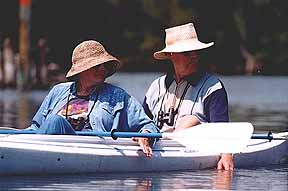More Absolutely Florida More Florida Wildlife More Florida Birding More Guided Tours

Seek Guidance Reaching the best vantage points usually takes an expert by G.K. Sharman If you’re a birding beginner, it helps to have someone who can explain what those beaked and befeathered things are. One way to get such information is to take a birding tour; we went out into the Merritt Island National Wildlife Refuge in Florida's Space Coast with an expert birding guide.Our tour started at Haulover Canal, a narrow waterway that connects the Indian River and Mosquito lagoons.
The first thing we did was paddle out toward a rookery, or nursery, island. Merritt Island National Wildlife Refuge is home to more than 300 species of birds, and most of them seemed to be represented on the mile-long spit of dry ground. Our guide, Brenda Smith, pointed out brown pelicans, double-crested cormorants, black-crowned night herons, tricolor herons, great and little blue herons, ibis, various egrets -- a United Nations of nesting birds.
Back on shore were a pair of black vultures, while an osprey tended a nest atop a channel marker piling. When we visited the island, it was early in the breeding season; couples were still getting together and only about 3,000 birds occupied the territory. By June, when the babies are hatched, the population soars to upwards of 5,500. "Then it sounds like a lunchroom full of kindergartners," Brenda said, "all crying ‘feed me! feed me!’" As fascinated as humans can get with the rookery, it’s important for them to keep a respectful distance, Brenda emphasized. Nesting birds can get spooked and fly away. If the parents are gone too long, the hot Florida sun can actually cook the eggs in the shell. With fledglings, she said, "the sun can boil their brains right inside their skulls." Besides explaining bird life, a good guide should be knowledgable about other aspects of the environment. For instance, Brenda told us:
|



